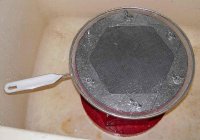savagedasher said:I don't worry mine hit the road after the first using.. So did the brass. When I found small particles of stainless in the water.
When you wipe a lobe on a camshaft and the oil is filtered and you trash a motor from particles the filter missed. I knew it wasn't something I want in my gun or down the barrel.
If particles of stainless is in the water some is imbed in the brass. You can do what you want.
But never for me. Larry
Here's my take.
The wash water I get after SS wet media tumbling is always filthy. I'm glad the gunk goes down the drain rather than accumulating in a batch of dry media which recycles it during the next tumbling process. After pouring off most of the wash water, I separate the SS media and then rinse both the brass and the SS media. Normally, there is a tiny bit of heavy stuff left in addition to the SS pins. I've taken a look at it, and of course I found a bit of very fine SS in the first batch. This is perfectly sensible since I imagine a certain amount of small SS filings and metal dust would be associated with the media manufacturing process.
But now, with well used media, I find mostly little pieces of brass and other heavy stuff not identifiable with ordinary magnification. I imagine most of this is left overs from trimming, primer pocket reaming, and the tiny particles which are bound to be scuffed off during primer seating and/or bullet seating. Some of it might be a by-product of the powder, brass, bullet, or primer manufacturing processes; I really don't know. All I know is that it has been removed from my cases and is sitting in the bottom edge of one of my rinse buckets.
I say GOOD. That's exactly where I want these little particles to be; in my wash water which I pour down the drain, not sitting in my cases or in a batch of dry media.
I suppose if someone were really worried about contaminating their brass, they could tumble and rinse just the SS media a few times before using it on brass, but that seems a little over the top to me.
I don't have an electron microscope mounted next to my loading press, but I have looked closely at my cleaned brass under reasonably high magnification and I've never found anything imbedded in the brass.
I've also built and re-built my fair share of racing engines and I hear what you're saying about contamination. However, I consider engines and cartridges as pretty much apples and oranges except to agree that cleanliness is generally a good thing, but you could say that about personal hygiene too..................... or at least some of us could.











